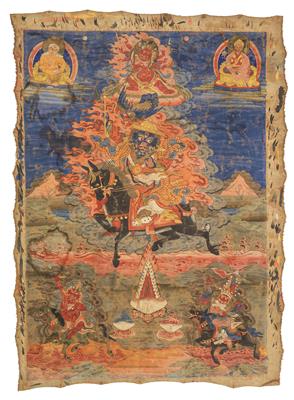Thangka of the Tutelary God Shingjachen, Tibet, 19th century

Nyingma and Gelug tradition, pigment and water soluble binding agent on fabric, gold paint, 54 x 37.5 cm, (Hr) We are grateful to Dipl. Ing. Uwe Niebuhr, BA MA for his assistance in cataloguing this work.
This thangka depicts the deity Shingjachen (Tib. shing bya can) from Tibetan Buddhism. Shingjachen is one of the five manifestations - also known as the "five Pehar kings" - of the tutelary god Pehar (Tib. pe har). Pehar was conquered in the 8th century by Guru Padmasambhava during the reign of Trisong Detsen (742-796, Tib. khri srong lde'u btsan) and integrated into the pantheon of Tibetan Buddhism as its tutelary deity (Skt. dharmapāla).
The five Pehar Kings represent all the attributes of the tutelary god Pehar: body, speech, mind, knowledge and actions. Shingjachen embodies knowledge. The five Pehar kings have one iconographic feature in common: they all wear the same characteristic hat, thus showing their connection. Their appearance varies in body colour, attribute, number of arms and mount.
Thus, in this thangka the two-armed Shingjachen is depicted with a blue body, riding a black horse, in keeping with his classical representation. His wrathful nature can be seen on his face: his mouth with fangs is wide open and his three eyes are bloodshot. Shingjachen has a beard, bushy eyebrows and curly hair reaching to his chin. He wears the characteristic round golden hat. A red and blue horned bird (Skt. garuḍa) with a snake in its beak flies over him. The tutelary god also wears flowing Tibetan robes, a cape made of tiger skin and boots. A white silk scarf with a medallion and a black snake hang around his neck. Shingjachen’s right arm is stretched out, his right hand makes the ‘gesture of banishing’ whilst holding a battle axe. He holds a demon sling near his chest, in his left hand.
The god is firmly seated in a red saddle with additional weapons: a bow, an arrow and a sword. His black horse, decorated with golden bells, looks just as wrathful, showing the same facial expression as his master. This furious duo hovers on a bubbling lake of blood in a mountainous landscape, surrounded by flames and blue-grey clouds. Sacrificial offerings to Shingjachen are visible in the lower center of the picture: three skull bowls, the middle one containing a sculpture of dough and butter (Tib. gtor ma).
The six-armed red Hayagrīva (Tib. rta mgrin) towers above Shingjachen, watching. He is depicted with three faces and eight legs in a side lunge. Three neighing green horse heads, Hayagrīva’s characteristic mark, are discernible in his hair. He stands on a lotus in a blue cloud, surrounded by flames. To Hayagrīva’s left sits Guru Padmasambhava, to his right King Trisong Detsen.
Riding below Shingjachen are two companions. They are typical of Pehar and can be identified on the basis of René Nebesky-Wojkowitz’s scholarly publication Oracles and Demons of Tibet (1959: 132). Riding a mule at the lower left is Sodag Gyalchen (Tib. srog bdag rgyal chen). It is characteristic for him to have only one eye and "one hair" on his head. Sodag Gyalchen is a red deity holding a skull bowl and cleaver in his hands - although the artist who executed this thangka probably forgot to add the cleaver’s blade. The second companion, riding a black horse on the lower right, is the red-faced Lekhen Togtsanpa (Tib. las mkhan thog btsan pa). Clad in armour, Lekhen Thogtsanpa wields a lance in his raised hand, the left one holding a demon sling.
Specialist: Regina Herbst
 Regina Herbst
Regina Herbst
+43-1-515 60-356
regina.herbst@dorotheum.at
23.03.2020 - 14:37
- Realized price: **
-
EUR 1,920.-
- Starting bid:
-
EUR 1,500.-
Thangka of the Tutelary God Shingjachen, Tibet, 19th century
Nyingma and Gelug tradition, pigment and water soluble binding agent on fabric, gold paint, 54 x 37.5 cm, (Hr) We are grateful to Dipl. Ing. Uwe Niebuhr, BA MA for his assistance in cataloguing this work.
This thangka depicts the deity Shingjachen (Tib. shing bya can) from Tibetan Buddhism. Shingjachen is one of the five manifestations - also known as the "five Pehar kings" - of the tutelary god Pehar (Tib. pe har). Pehar was conquered in the 8th century by Guru Padmasambhava during the reign of Trisong Detsen (742-796, Tib. khri srong lde'u btsan) and integrated into the pantheon of Tibetan Buddhism as its tutelary deity (Skt. dharmapāla).
The five Pehar Kings represent all the attributes of the tutelary god Pehar: body, speech, mind, knowledge and actions. Shingjachen embodies knowledge. The five Pehar kings have one iconographic feature in common: they all wear the same characteristic hat, thus showing their connection. Their appearance varies in body colour, attribute, number of arms and mount.
Thus, in this thangka the two-armed Shingjachen is depicted with a blue body, riding a black horse, in keeping with his classical representation. His wrathful nature can be seen on his face: his mouth with fangs is wide open and his three eyes are bloodshot. Shingjachen has a beard, bushy eyebrows and curly hair reaching to his chin. He wears the characteristic round golden hat. A red and blue horned bird (Skt. garuḍa) with a snake in its beak flies over him. The tutelary god also wears flowing Tibetan robes, a cape made of tiger skin and boots. A white silk scarf with a medallion and a black snake hang around his neck. Shingjachen’s right arm is stretched out, his right hand makes the ‘gesture of banishing’ whilst holding a battle axe. He holds a demon sling near his chest, in his left hand.
The god is firmly seated in a red saddle with additional weapons: a bow, an arrow and a sword. His black horse, decorated with golden bells, looks just as wrathful, showing the same facial expression as his master. This furious duo hovers on a bubbling lake of blood in a mountainous landscape, surrounded by flames and blue-grey clouds. Sacrificial offerings to Shingjachen are visible in the lower center of the picture: three skull bowls, the middle one containing a sculpture of dough and butter (Tib. gtor ma).
The six-armed red Hayagrīva (Tib. rta mgrin) towers above Shingjachen, watching. He is depicted with three faces and eight legs in a side lunge. Three neighing green horse heads, Hayagrīva’s characteristic mark, are discernible in his hair. He stands on a lotus in a blue cloud, surrounded by flames. To Hayagrīva’s left sits Guru Padmasambhava, to his right King Trisong Detsen.
Riding below Shingjachen are two companions. They are typical of Pehar and can be identified on the basis of René Nebesky-Wojkowitz’s scholarly publication Oracles and Demons of Tibet (1959: 132). Riding a mule at the lower left is Sodag Gyalchen (Tib. srog bdag rgyal chen). It is characteristic for him to have only one eye and "one hair" on his head. Sodag Gyalchen is a red deity holding a skull bowl and cleaver in his hands - although the artist who executed this thangka probably forgot to add the cleaver’s blade. The second companion, riding a black horse on the lower right, is the red-faced Lekhen Togtsanpa (Tib. las mkhan thog btsan pa). Clad in armour, Lekhen Thogtsanpa wields a lance in his raised hand, the left one holding a demon sling.
Specialist: Regina Herbst
 Regina Herbst
Regina Herbst
+43-1-515 60-356
regina.herbst@dorotheum.at
|
Buyers hotline
Mon.-Fri.: 10.00am - 5.00pm
kundendienst@dorotheum.at +43 1 515 60 200 |
| Auction: | Antiques (Clocks, Asian Art, Metalwork, Faience, Folk Art, Sculpture) |
| Auction type: | Online auction |
| Date: | 23.03.2020 - 14:37 |
| Location: | Vienna | Palais Dorotheum |
| Exhibition: | online |
** Purchase price incl. charges and taxes
It is not possible to turn in online buying orders anymore. The auction is in preparation or has been executed already.
